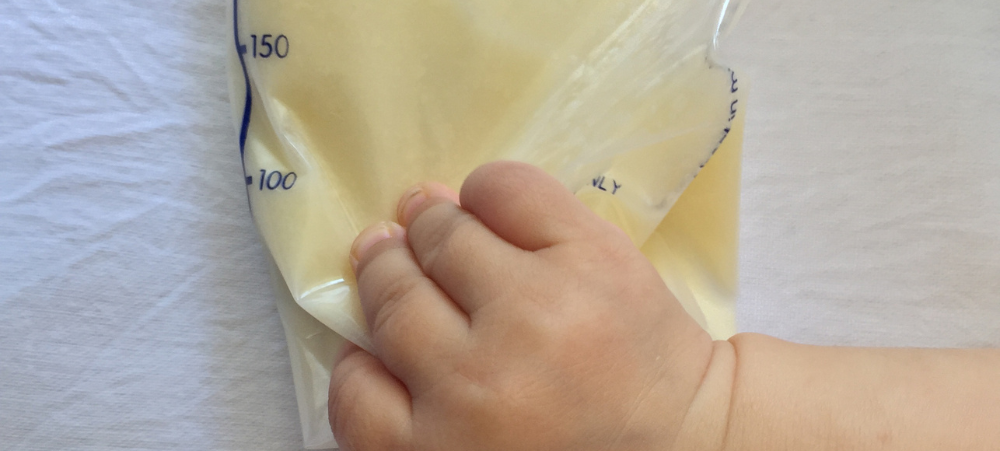Expressed breast milk is the best food for your baby to have when you’re not there. So how do you store and use your milk safely?
If you’re returning to work, heading to a gym class or simply want your partner to give a feed so you can catch up on some sleep, you can express your breast milk and store it for your baby to have when you’re not around. Expressed milk keeps most of its health-giving benefits, so if you have to miss a feed, it’s far better for your baby than any type of formula. But good hygiene is vital to ensure that stored milk is safe for your baby – read on to find out how to store breast milk properly.
Which Breast Milk Storage Method Is Best?
Breast milk is better for your baby than formula – but freshly expressed breast milk is preferable to refrigerated, and refrigerated is better than frozen. That’s because freshly expressed milk has the best bacteria-fighting properties and is higher in antioxidants, vitamins and fat than milk that has been refrigerated or frozen.4
Storage Guidelines For Freshly Expressed Breast Milk (For Healthy Term Babies)2,3:
If you have expressed breast milk cleanly and safely, you can store it at room temperature, in the fridge, or in the freezer, depending on how soon you want to use it. Follow this storage location and temperatures guidelines for freshly expressed breast milk (for healthy term babies)2,3:
| Storage place | Room temperature 16 °C to 25 °C (60 °F to 77 °F) | Refrigerator 4 °C (39 °F) or colder | Freezer -18 °C (0 °F ) or colder | Previously frozen breast milk thawed in the refrigerator |
| Safe storage time | Up to four hours is bestUp to six hours for milk expressed under very clean conditions* | Up to three days is bestUp to five days for milk expressed under very clean conditions* | Up to six months is bestUp to nine months for milk expressed under very clean conditions* | Up to two hours at room temperatureUp to 24 hours in the refrigeratorDo not refreeze |
* Very clean conditions means rigorously following the guidance in our article on cleaning and sanitising your breast pump.These guidelines for storing and defrosting breast milk are a recommendation – contact your lactation consultant or breastfeeding specialist for further information.
If your baby is in a neonatal intensive care unit (NICU) or special care ward, your hospital may have stricter recommendations for cleaning and storage.
If you’re refrigerating or freezing expressed milk, always label the bottles or bags with the amount and the date it was pumped, so you can track and manage your stored milk.
Guidelines For Using Expressed Breast Milk
Stored breast milk tends to separate into layers, with the fat (cream) rising to the top. Gently swirl the bottle to mix the layers before feeding your baby. Vigorous stirring or shaking can damage some of the milk’s nutritional and protective components.5
When your baby feeds on expressed breast milk from a cup or bottle, bacteria from his mouth can naturally end up in the milk. For this reason, it’s best to throw away any leftover, partly drunk milk within one to two hours of his initial feed. To avoid wasting expressed milk, it’s always a good idea to store it in small amounts, and only use what you need.2
How To Store Breast Milk In The Refrigerator2,3
Follow these guidelines to store expressed milk safely in the fridge:
- Refrigerate your breast milk as soon as possible after expressing.
- Store your milk in clean breast milk bottles or storage bags made from BPA-free materials. BPA is a chemical that was previously widely used in plastic containers and coatings, which many manufacturers are phasing out due to its uncertain long-term effects.
- Small amounts of expressed milk may be added to the same refrigerated container, provided the milk you want to add is cooled in the fridge beforehand. Don’t add body-temperature milk to already cooled milk.
- Store breast milk in the coldest part of the fridge – at the back, on the shelf above the vegetable compartment. Don’t keep it in the fridge door where the temperature is less consistent.
How To Store Breast Milk In The Freezer2,3
Read on for how to freeze breast milk safely:
- Freeze your breast milk as soon as possible after expressing.
- Expressed milk may be added to already frozen breast milk, provided the milk you want to add is cooled in the fridge beforehand. Don’t add body-temperature milk to frozen milk.
- For easier thawing and minimal wastage, store your milk in small portions (less than 60 ml). These can be combined after defrosting.
- Check that your breast milk storage containers can be used in the freezer – some products (such as glass bottles) may crack at very low temperatures. Medela breast milk storage bags are ideal for storing frozen breast milk as they’re freezer-proof, ready to be used and easy to label.
- Don’t fill bottles or bags more than three-quarters full, as breast milk expands during freezing.
- Store frozen breast milk at the back of the freezer where the temperature is most consistent. Keep it away from the walls of self-defrosting freezers.
How To Defrost Breast Milk2,3
Take care when defrosting breast milk to make sure it’s safe for your baby:
- Breast milk can be defrosted in the fridge, normally in around 12 hours. Alternatively, hold the bottle or bag of frozen milk under warm running water (a maximum of 37 °C or 99 °F). Don’t leave frozen breast milk to defrost at room temperature.
- Once fully thawed, previously frozen breast milk may be kept at room temperature for a maximum of two hours or in the refrigerator for up to 24 hours.
- Don’t thaw or heat frozen breast milk in a microwave or in boiling water. These can damage its nutritional and protective properties and create hot spots that could scald your baby.
- Thawed breast milk left at room temperature should be fed to your baby within two hours or thrown away.
- Never re-freeze breast milk once thawed.
How To Warm Your Stored Breast Milk2,3
Healthy, full-term babies can drink breast milk at room temperature or warmed to body temperature. Some have a preference; others don’t seem to mind.
- To warm your milk, place the breast milk bottle or bag into a cup, jug or bowl of lukewarm water for a few minutes to bring it to body temperature (37 °C). Alternatively, use a bottle warmer. Do not allow the temperature to go above 40 °C and do not use a microwave, as this can overheat your milk.
- Gently swirl the bottle or bag, without shaking or stirring, to mix any separated fat (see above).
Why Does My Stored Breast Milk Smell Odd?
You may notice that your refrigerated or defrosted breast milk can sometimes smell different. This is because an enzyme called lipase breaks down fats and releases fatty acids – a process that helps prevent the growth of harmful bacteria.
Some mums report that their stored milk has a soapy or rancid smell. But if you’ve followed all the safe-storage guidelines in this article, it will be perfectly fine to use.2
Breast Milk Storage On The Go
If you have to transport your milk between work and home or daycare, use a cooler bag with ice packs.2 For more on pumping and storing milk on the move, read our article on travelling and pumping.
- A Comprehensive Guide to Medela Breast Pumps - September 3, 2024
- How to store, freeze and thaw breast milk - August 16, 2024
- How to use a Medela breast pump: 12 top tips - August 1, 2024




